|
We are presently active collaborators in various wakefield experiments and one astrophysics related experiments
|
-
Proton-driven plasma wakefield acceleration (PWFA) experiment at
CERN.
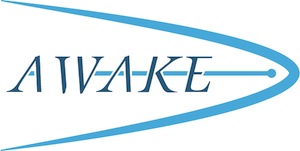
Proton bunches carrying very large mounts of energy per bunch are now routinely collided at the CERN
Large Hadron Collider (LHC).
Numerical simulations show that a single proton bunch can accelerate a following (witness) electron bunch from a low energy (a few GeVs) to more than
half a TeV in a single plasma section a few hubdres of meters long
(A. Caldwell et al., Nature Physics 5, 363 (2009)).
However, in order to frive accelerating fields in the GV/m, the bunch must be ~100µm-long and carry a few kA! Such bunches do not exist today.
An experimental program to study the physics of plasma wakefields driven by high energy proton bunches was approved by the CERN in August 2013. The first experiments will use a rather long proton bunch (~12cm)
(G. Xia et al., J. Plasma Phys., 1-7 (2012)).
This long bunch self modulates at the plasma wavelength spatial scale due to a transverse two-stream instability
(N. Kumar et al., Phys. Rev. Lett. 104, 255003 (2010)).
This instability is driven by the transverse component of the low amplitude wakefields driven by the long (when compared to the plasma wavelength) proton bunch.
These wakefields lead to periodic increase/decrease in bunch density, which then drive larger wakefields, thereby providing the feedback for the instability to grow.
The density-modulated proton bunch then drives large amplitude wakefields in a 10m-long plasma. The name of the experiment and of the forming collaboration is "AWAKE" for Advanced WAKefield Experiment.
More information abot the AWAKE-related activities at the institute can be found here.
|
-
SLAC-FACET experiment E-209: Self-modulation of long lepton bunches in long plasmas.

We started an experimental program to study the physics of self-modulation of charged particle bunches in long, dense plasmas. The first experiments will use a rather long proton bunch (~12cm). It was shown that long bunches (compared to the relativiatic plasma wave period) become self-modulated with the plasma period and then resontly drive wakefields to large amplitudes
(N. Kumar et al., Phys. Rev. Lett. 104, 255003 (2010)).
Unlike the proton case, 20GeV electron or positron bunches self-modulate over cm-distances
(J. Vieira et al., Phys. Plasmas 19, 063105 (2012)).
We therefore propose to send long (500 microns) electron and positon bunches used in early PWFA experiments with low plasma denities (1014-1015cm-3)
(P. Muggli and M.J. Hogan, New J. Phys. 12, 045022 (2010))
into the dense (1016-1017cm-3) plasmas used for current PWFA experiments at FACET
(M.J. Hogan et al., New J. Phys. 12, 055030 (2010)).
Remarkable expected results include: - reaching the nonlinear regime of the PWFA, - saturation of the SMi in approximately 15cm of plasma, - wakefield aplitudes in excess of 20GV/m, - energy gain and loss by bunch particles in the multi-GeV range, etc.
Note that these experiments require a preformed plasma.
|
-
The E-200 Plasma Wakefield Experiment at the Stanford Linear Accelerator Center
(SLAC) FACET.
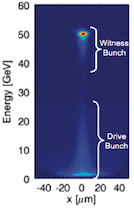
The goal of this experiment is to study plasma wakefield acceleration in the context of a high energy accelerator. The plasma wave or wakefield is driven by a single ultra-short
(10-40 µm long), ultra-relativistic (20.3 GeV) electron bunch. In this single bunch scheme, the plasma density is adjusted so that, while the core electrons lose energy
in driving the plasma wake, the trailing electrons gain energy. For the bunch lengths of interest, the plasma density is in the 1-3.5x1017 cm-3 range.
The accelerating gradient expected with a bunch with ≈1.8x1010 e- is in the 35-45 GV/m range. A unique feature of this experiment is that the plasma is created
through field-ionization of a lithium vapor by the large space-charge field of the high peak current (>10 kA) electron bunch. The electron bunch therefore creates its own plasma and accelerating structure.
Recent results have shown energy gains in the 4 GeV range over a plasma length of about 10 cm, demonstrating the excitation and sustainability of gradients in the 40 GV/m range
over a long distance
(M. J. Hogan et al., Phys. Rev. Lett. 95, 054802, (2005)).
Later experiments have shown the increase in enery gain with plasma length, with measured gains well in excess of 10 GeV over a plasma legth of only 32 cm.
(P. Muggli et al., New J. Phys. 12, 045022 (2010)).
These experiments have also once again shown the reproducibility of the acceleration process. An energy gain of 42 GeV over only 85 cm of plasma was then measured
(I. Blumenfeld et al., Nature 445, 741-744 (15 February 2007)).
These results make the PWFA one of the lead candidates as a new technology for a future, more compact and more affordable e-/e+ collider at the energy frontier.
Based on the remarquable results obtained in the previous experiments, a new and unique facility called FACET is currently under construction to study and develop the PWFA in second generation experiments.
This facility will deliver ultra-relativistic, ultra-short electrons and positron bunches with parameters similar to those that were available for the E-167 experiments.
In particular, experiments at FACET will be devoted to the accelleration of electron and/or positron bunches with a narrow energy spread,
the high gradient acceleration of short positron bunches, the demonstration of the preservation of the incoming beam emittance in conjunction with large energy gain,
and the optimization of the acceleration process including loading of the plasma wake by the witness bunch
(see for example M.J. Hogan et al., New J. Phys. 12, 055030 (2010)).
|
-
The Plasma Wakefield Experiment Driven by a Train of Bunches at the
Brookhaven National Laboratory (BNL),
Accelerator Test Facility (ATF).
This experiment is a continuation of the AE31 experiment.
The goal of this experiment is to use a train of 1-10 microbunches produced using a method we recently demonstrated
(P. Muggli et al., Phys. Rev. Lett. 101, 054801 (2008) and P. Muggli et al., Phys. Rev. ST Accel. Beams 13, 052803 (2010)).
In this method a mask is placed in a dispersive region of the beam line (the dogleg in the case of the ATF).
The electron bunch is ran off crest along the linac so that it enters the dogleg withan energy/time correlation.
Therfore, the mask imprints its pattern on the beam in the correlated energy/space plane in the dogleg.
After the dogleg, the energy space correlation is returned to a time correlation and the bunch has a temporal microbunch structure.
The pattern of the mask can be designed to produce a pattern appropriate for specific application.
For PWFA experiments, the number of drive bunches can be chosen, and a witness bunch can be produced with the appropriate relative phase in the wakefield for maximum acceleration.
The plasma density and the bunch train can be adjusted for maximum wakefields or maximum transformer ratio.
Multi-bunch PWFAs can be used to multiply the energy of the witness bunch by the number of drive bunches (beyond energy doubling experiments), and to maximize the energy transfer efficiency.
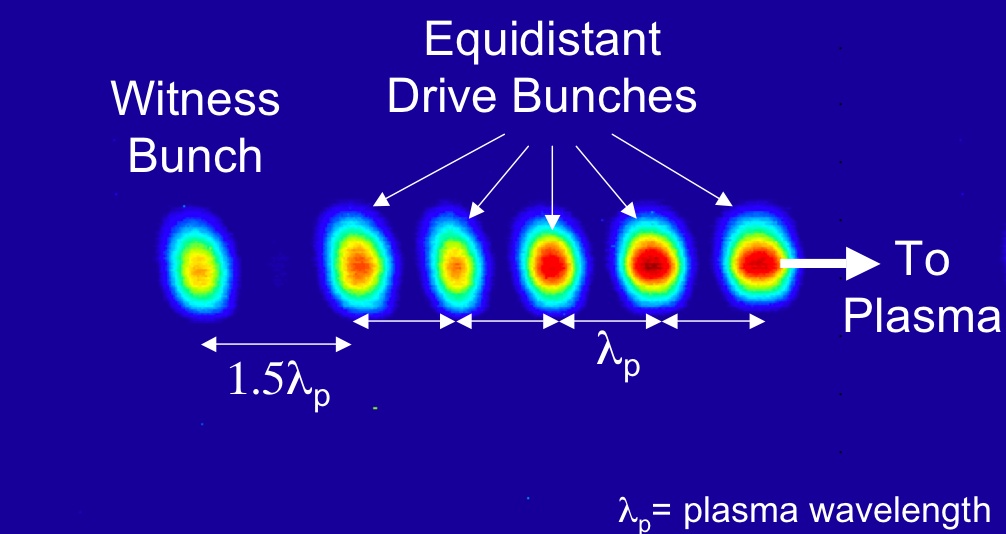
An example of a train of five equidistant drive bunches followed by a witness bunch separted by one and a half time the distance between the drive bunches.
|
-
Visualization Plasma Wakefield at the Brookhaven National Laboratory (BNL),
Accelerator Test Facility (ATF).
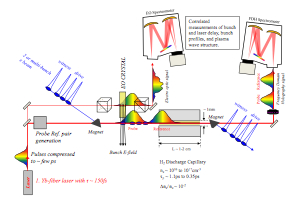
Plasma wakefields are sustained by a perturbation of the plasma electron density. This perturbation can be visualized by interferometric methods. In particular, this perturbation
propagating at (nearly) the speed of light can be affect the phase of a laser pulse propagating co-linearly with the perturbation. This probe pulse can be interfered with a reference puse propagating outside the plasma of ahead of the density perturbation. When the laser pulse has a frequency chirp (oscillation
frequency changing in time along the pulse), the time structure (integrated along the plasma) can be visualized using Fourier Domain holograpy (FDH). This has been demonstrated
in laser wakefield accelerator (LWFA) experiments
(N. H. Matlis et al., Nature Physics 2, 749 - 753 (2006)).
This method will be applied to the PWFA experiments driven by a train of electron bunches. The challenge in these experiments is that in principle the parameters lead to a linear response of the plasma to the bunch train perturbation (linear regime of the PWFA).
In this regime, the plasma density perturbation is small when compared to the initial density. That means that the phase shift accumulated by the various laser wavelengths is small.
However, the beam can in principle be focused to a smaller transverse size at the plasma entrance, driving the interaction in the nonlinear regime. In this regime large density perturbations
are generated, leading to the accumulation of significant phase shift by the probe laser pulse. Visualization of the wakefield will show directly the increase in wakefield resulting from the resonant excitation by the periodic bunch.
This experiment will be performed in collaboration with the group of Prof. Downer at the University of Texas, Austin
(R. Zgadzaj et al., AIP Conf. Proc. 1299, pp. 505 (2010)).
|
-
The Current Filamantation Instability.
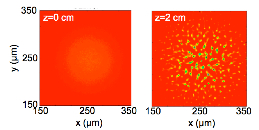
The regimes of interaction of particle beams with plasma can, for example, be characterized with respect to the ratio of the transverse beam size σr to the plasma collisionless skin depth c/ωpe.
When σr<< c/ωpe, the regime is that of the plasma wakefields. The plasma return current essentially returns outside of the beam radius. The dominant instability is the hose instability. We study this regime extensively in the PWFA experiments at SLAC and at BNL ATF (see here above).
When σr>> c/ωpe, the plasma return current flows inside the beam radius. The dominant instability is the two stream instability when the beam is non-relativistic, and the current filamentation instability (CFI) when the beam is relativistic. The CFI causes the beam to break up transversely
into current filaments with typical radius of the order of c/ωpe, carrying currents larger than that of the incoming beam. These filaments therefore generate larger magnetic fields than initially present in the plasma. The generation of magnetic fields by CFI occurring when large size plasma sheets encounter
the space plasma background maybe play an important role in the after-glow of gamma ray bursts (GRBs). The CFI of hot electron beam produced in the fast igniter scheme of inertial confinement fusion (ICF) may also play an important role in the location and amount of energy deposited in the pellet fuel.
Therefore, studying and understanding CFI is interesting and important.
The electron beam available at the BNL-ATF is ideal to study the CFI.
The beam and plasma (capillary discharge) parameters can be independently controlled.
Simulation results indicate that the instability should be observed after only one or two centimeters of plasma
(B. Allen et al., AIP Conf. Proc. 1299, pp. 516 (2010)).
Experimental results recently obtained (2012) revealed many of the expected feature of CFI:
-The transition from plasma focusing at low plasma density for which σr<< c/ωpe to CFI when σr>2
-The observation of more than 1-6 filaments in the CFI regime with their number increasing with plasma density
-The random nature of the instability with the number of filaments and their location varying form event to event with similar parameters
-The linear scaling of the filaments size with c/ωpe when in the CFI regime
-The suppresion of the CFI instabilty when decreasing the bunch charge (due to the lowering of the instability groth rate
These results were published in B. Allen et al., Phys. Rev. Lett. 109, 185007 (2012).
|
-
Dielectric loaded accelerator experiments with trains of microbunches at the
Brookhaven National Laboratory (BNL),
Accelerator Test Facility (ATF).
Dielectric loaded accelerators (DLAs) are another example of a two-beam co-linear accelerators similar in many respect to the the plasma wakefield accelerator (PWFA).
The main difference is the in the DLA the particle beam can only excite one or more modes of the
dielectric structure. The frequency of the modes depends on the inner and outer radius of the dielectric lining, as well as on its dielectric constant (or permetivity).
Therefore, unlike in the plasma case where any bunch or train of bunches can couple to the plasma mode, in the DLA
only trains with the appropriate periodicity can couple to the discrete modes of the pre-existing structure. Trains of bunches can therefore be used to select the oscillating mode.
Also, a train of bunches can excite low group velocity modes, and efficiently extract the electromagnetic energy since
many bunches can be accelerated by the field energy bu the first bunches. The DLA can also be used as a powerful source of high frequency (~THz) radiation
(A. M. Cook et al. , Phys. Rev. Lett. 103, 095003 (2009)).
Transverse wakefields can lead to beam deflection and loss. Transverse wakefields can be minimized and the bunch current maximized by using planar dielectric structures.
The first results with such structure waer obtained at the ATF
G. Andonian et al. , Phys. Rev. Lett. 108, 244801 (2012)
|
-
The Dielectric Wakefield T-481 Test Beam and E-201 experiment at the Stanford Linear Accelerator Center
(SLAC).
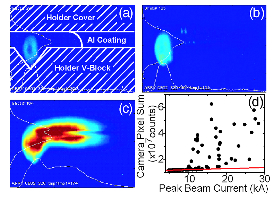
The goal of this experiment is to study the excitation through Cherenkov radiation of GV/m wakefields in dielectric tubes
(J.B. Rosenzweig et al., AIP Conference Proceedings, December 7, 2004, Volume 737, Issue 1, pp. 811-817).
Such large wakefields can in principle be excited by the high current (<30 kA), ultra-short (>30 fs) electron bunches now available at SLAC.
These GV/m wakefields can be used to accelerate a bunch trailing the drive bunch by the appropriate distance.
The advantage of a dielectric wakefield accelerator over a plasma wakefield accelerator is that the process is symmetric for electrons and positrons.
However, the wakefield amplitude is limited by damage of the dielectric tube. The first test beam was dedicated to the study of damage as a function of the bunch length
(M.C. Thompson et al., Proc. 2005 PAC conference).
The breakdown field was estimated at about 13GV/m on the dielectric surface
(M.C. Thompson et al., Phys. Rev. Lett. 100, 214801 (2008))
Further experiments will focus on the study of the emission in vacuum of the THz frequency range wakefields.
|
|
|